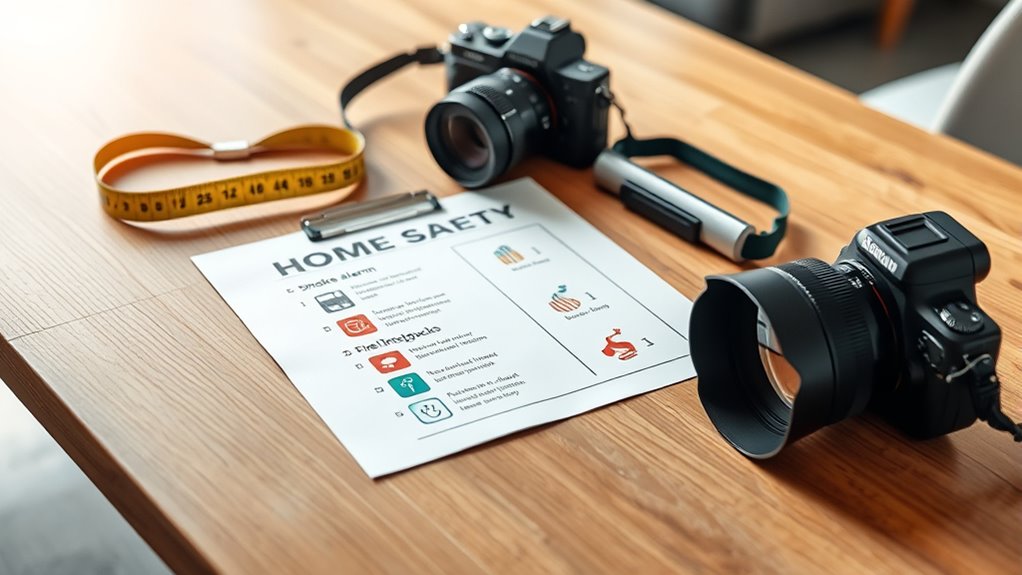To measure your home safety checklist effectively, start by systematically inspecting key areas like fire devices, electrical outlets, and entry points. Check escape routes and ensure all safety equipment is accessible and functional. Evaluate hazards in the kitchen, living spaces, and flooring. Confirm smoke and carbon monoxide detectors work, and review storage of hazardous materials. Proper lighting and emergency plans are also crucial. Keep questioning and assessing each aspect; there’s more to discover to keep your home truly safe.
Key Takeaways
- Conduct a thorough walk-through to inspect fire exits, electrical systems, and hazard areas, ensuring all safety features are functional and accessible.
- Use standardized safety checklists aligned with fire, electrical, and hazard prevention protocols for comprehensive assessment.
- Regularly test smoke alarms, GFCI outlets, and fire extinguishers, documenting results to track safety compliance over time.
- Involve all household members in safety drills and evaluations to identify potential gaps and improve preparedness.
- Prioritize hazards based on risk level, addressing critical issues immediately and scheduling repairs or upgrades accordingly.
Assessing Fire Safety Devices and Escape Routes

Ensuring your fire safety devices are working properly is essential for protecting your home and loved ones. Check that your fire extinguisher is fully charged, accessible, and mounted in an easy-to-reach spot in your kitchen or garage. Regularly inspect the pressure gauge and replace it if it’s not in the green zone. Make sure your emergency escape routes are clear of obstacles and easy to access from every room. Practice your escape plan with family members so everyone knows how to evacuate quickly and safely. Confirm that windows and doors leading to escape routes open smoothly. Additionally, powerful persuasive words can be used to reinforce safety messaging and ensure everyone understands the importance of fire preparedness. These simple steps help ensure you’re prepared in case of a fire, giving you peace of mind that your safety devices and escape plan are reliable when it matters most.
Inspecting Electrical Systems and Outlets

Start by checking all your electrical wires for any fraying or damage to guarantee potential hazards. Test your outlets for ground faults to make sure they’re functioning safely. Also, make sure each outlet has the proper covers to protect children and reduce the risk of shocks. Additionally, ensure that your electrical system is up to date with current safety standards to prevent possible electrical issues.
Check for Frayed Wires
Frayed wires can pose serious safety hazards, so it’s essential to regularly inspect your electrical systems and outlets. Look for damaged cable insulation or exposed electrical wiring, which can lead to shocks or fires. Carefully examine cords and wiring behind appliances or outlets for signs of wear. Damaged wiring often shows fraying, cracking, or discoloration. If you notice any issues, avoid using the affected circuit until repairs are made. Addressing frayed wires promptly can prevent accidents and electrical failures. Use a flashlight to improve visibility in dark areas and ensure thorough inspection. Remember, faulty electrical wiring compromises home safety and should be handled by a professional electrician. Regular checks help maintain a safe environment for everyone in your home. Proper inspection techniques and consistent maintenance are key to identifying potential problems early.
Test Ground Faults
Have you tested your outlets for ground faults lately? Ground fault testing is essential to maintain electrical safety in your home. Use a Ground Fault Circuit Interrupter (GFCI) tester to check outlets, especially in kitchens, bathrooms, and outdoor areas. Plug the tester into each outlet and press the test button; if the outlet doesn’t trip or the indicator doesn’t show a fault, it’s safe. Regularly testing ground faults helps prevent electrical shocks and fires caused by faulty wiring. Remember, even if outlets look fine, hidden ground faults can exist, posing risks. Make it a habit to perform these tests periodically. Ensuring proper ground fault testing is a simple yet vital step to protect your household from electrical hazards and improve overall electrical safety. Additionally, understanding Soulmate angel numbers can provide insights into your love life and relationships.
Ensure Proper Outlet Covers
Regularly inspecting your outlet covers is a simple yet effective way to maintain electrical safety. Damaged or missing covers expose children to electrical shock and compromise appliance safety. To guarantee proper childproofing measures, check that all outlets have secure, undamaged covers. Replace any cracked or missing covers immediately. Consider installing tamper-resistant outlets for added protection, especially in homes with young children. Keep outlets clear of dust and debris to prevent fire hazards. Use outlet covers that fit snugly and are appropriate for your appliances. Proper outlet covers prevent accidental contact and help maintain a safe environment. Regular inspections are key to catching issues early and assure your electrical system remains secure for everyone in your home. Incorporating smart safety solutions, such as AI-powered monitoring systems, can further enhance your home safety by alerting you to potential electrical issues before they become hazards.
Evaluating Kitchen and Appliance Safety
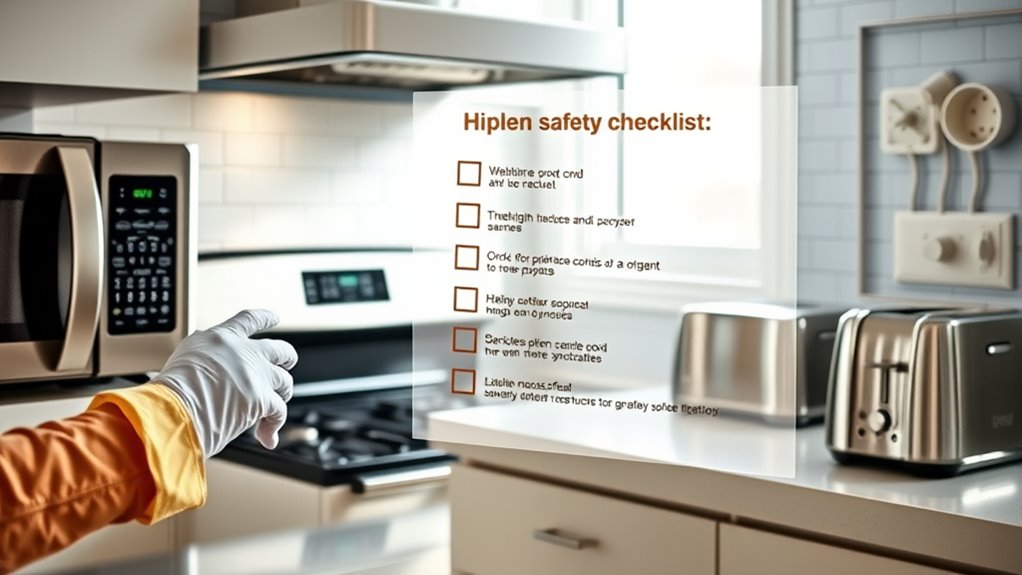
Making certain your kitchen and appliances are safe is essential to prevent accidents and fires. Start by checking appliance maintenance—make sure appliances are clean, cords are undamaged, and filters are replaced as needed. Regularly inspect for frayed wires or overheating issues. Good kitchen storage also plays a vital role; keep sharp tools and heavy items secured and away from children. Clear countertops and organize cabinets to prevent clutter that could cause spills or accidents. Test smoke alarms nearby and ensure fire extinguishers are accessible and functional. Avoid overloading outlets and unplug unused appliances to reduce fire risk. By maintaining appliances properly and organizing kitchen storage efficiently, you considerably improve safety in one of the most accident-prone areas of your home. Proper kitchen safety practices and vigilant maintenance can further reduce risks.
Checking for Fall Hazards and Safe Flooring

Start by looking for areas where you or others might trip or slip, such as loose rugs or uneven surfaces. Make sure your flooring is secure, slip-resistant, and free of clutter. Addressing these hazards now can help prevent falls and keep your home safer for everyone. Regularly inspecting and maintaining your flooring can also help identify potential issues before they become hazards preventive maintenance.
Spot Fall Risks
To reduce the risk of falls, you need to actively check your home for hazards and make certain flooring is safe. Start by inspecting areas where rugs placement could cause tripping—ensure rugs are secure and non-slip. Check stairways for sturdy stair handrails that provide support and stability. Look for uneven or loose flooring that could lead to slipping or tripping. Pay attention to clutter or objects on the floor that may cause hazards. Also, verify that high-traffic zones are clear and well-lit. Regularly monitor for symptoms of health issues that could affect balance, such as dizziness or weakness, to further prevent falls.
- Confirm rugs are secured and have non-slip backing
- Ensure stair handrails are firmly attached and easy to grasp
- Identify uneven or loose flooring sections
- Maintain clear pathways free of clutter and obstacles
Ensure Flooring Safety
Checking your flooring regularly is essential to prevent falls and injuries. Inspect area rugs to make certain they lie flat and have slip-resistant backing. Loose edges or curled corners can cause tripping hazards, so secure or replace them as needed. Pay attention to flooring surfaces like hardwood, tile, or linoleum for smoothness and stability; add slip-resistant coatings if necessary. Keep floors clean and dry, especially in high-traffic areas, to reduce the risk of slips. Use rugs with good slip resistance on slippery surfaces, but always secure them to prevent movement. Regular maintenance and mindful placement help maintain a safe environment. By staying vigilant and addressing potential hazards promptly, you create a safer home for everyone. Understanding credit card security measures can also help protect your financial information from theft or fraud.
Securing Windows, Doors, and Locks
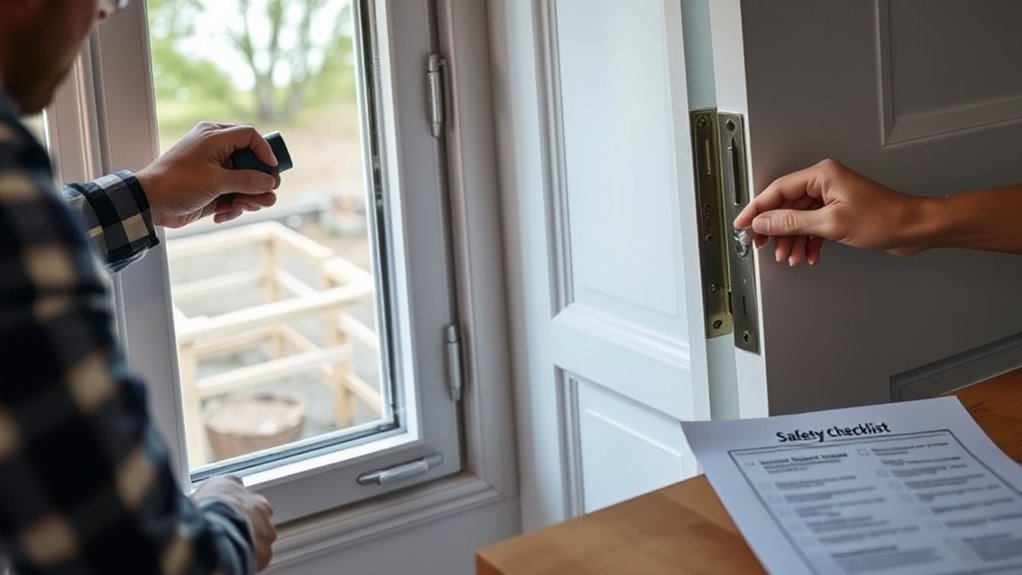
Securing your windows, doors, and locks is essential to prevent unauthorized entry and guarantee your safety. Proper window security and sturdy door locks are your first line of defense against intruders. Regularly inspect all entry points and ensure locks are functioning correctly. Reinforce weak spots, such as glass panes or door frames, to make forced entry difficult. Consider upgrading to high-quality locks or adding additional security features for enhanced protection.
- Install deadbolt locks on exterior doors
- Use security bars or window locks for added protection
- Reinforce door frames and hinges
- Consider smart locks for keyless access
Reviewing Smoke and Carbon Monoxide Detectors

Regularly reviewing your smoke and carbon monoxide detectors is essential to guarantee they’re working properly and providing reliable protection. Alarm maintenance involves testing each detector monthly by pressing the test button, ensuring the alarm sounds clearly. Check the batteries annually, or sooner if you notice any decline in performance. Proper detector placement is critical; install smoke detectors on every level and outside sleeping areas, while carbon monoxide detectors should be placed near bedrooms and on each floor. Avoid placing detectors in drafty areas, near vents, or close to cooking appliances, as these can cause false alarms. Regular reviews help you identify issues early, ensuring all alarms are functional when you need them most. Stay proactive to keep your home safe and protected. Incorporating professional voice actors or expert advice can also enhance the clarity and effectiveness of your safety alerts.
Identifying Toxic and Hazardous Materials
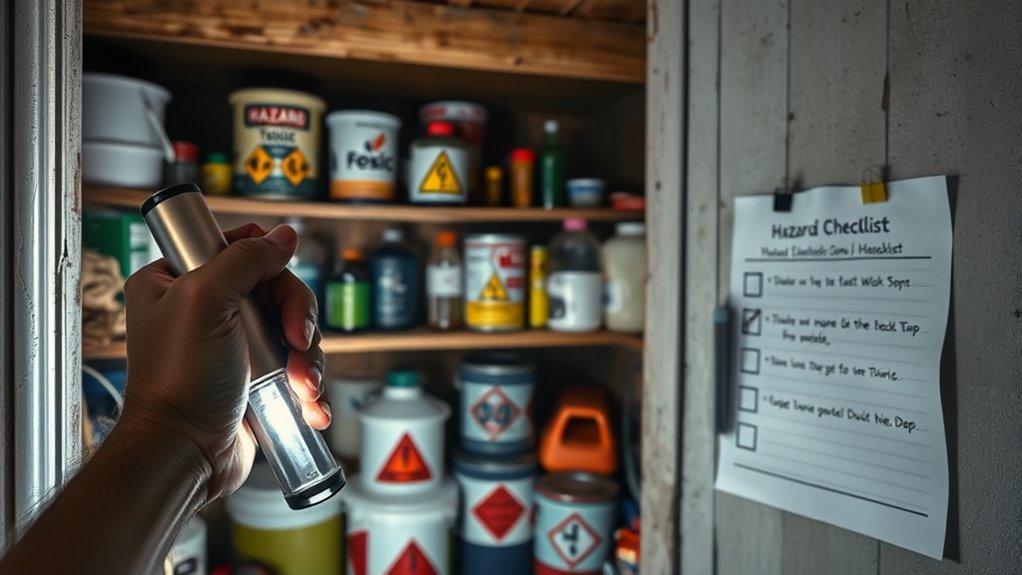
How can you effectively identify toxic and hazardous materials in your home? Start by inspecting common sources like cleaning products, paints, and pesticides. Look for labels indicating toxicity or hazard warnings, such as signal words or symbols. Conduct regular toxic substance identification to spot items that may contain harmful chemicals. When handling hazardous materials, always follow safety guidelines to prevent accidents. Additionally, be aware of the presence of dangerous substances in your environment, as proper identification is essential for ensuring safety.
Ensuring Proper Lighting Throughout the Home
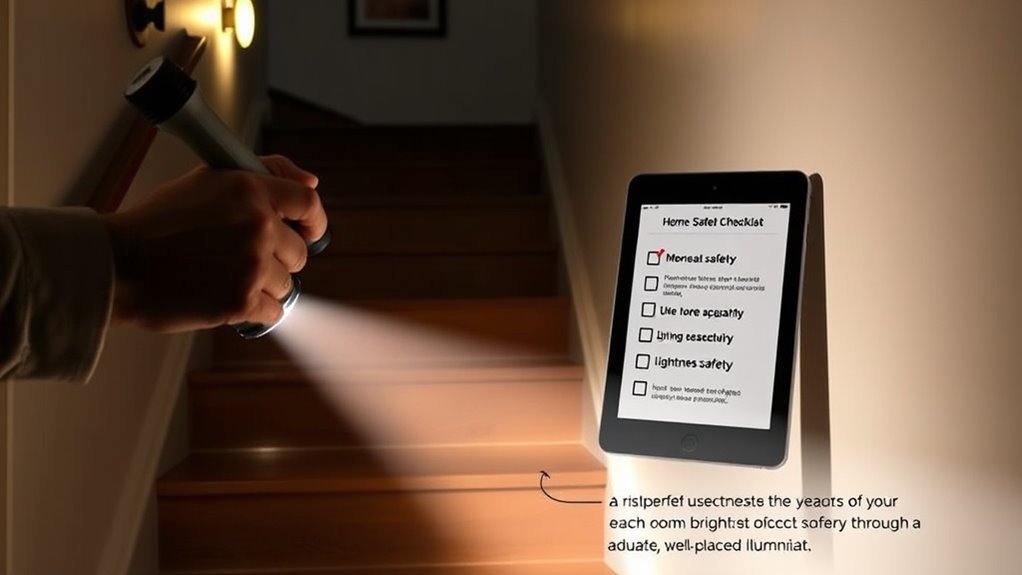
Proper lighting plays an essential role in maintaining a safe and functional home environment. Good lighting placement ensures every area is well-lit, reducing the risk of trips and falls. Use a combination of overhead lights, task lighting, and nightlights to illuminate hallways, staircases, and entryways effectively. Maximize natural light during the day by keeping windows unobstructed and using light-colored curtains or blinds. This not only brightens your space but also conserves energy. Regularly check and replace burnt-out bulbs to maintain consistent illumination. Consider installing motion-activated lighting in dark areas like basements or garages for added safety. Proper lighting is crucial for visibility and security, helping you navigate your home confidently and preventing accidents. Ensuring the right earbud fit can also improve your overall safety by preventing distractions caused by discomfort or poor sound quality.
Creating and Practicing Emergency Plans
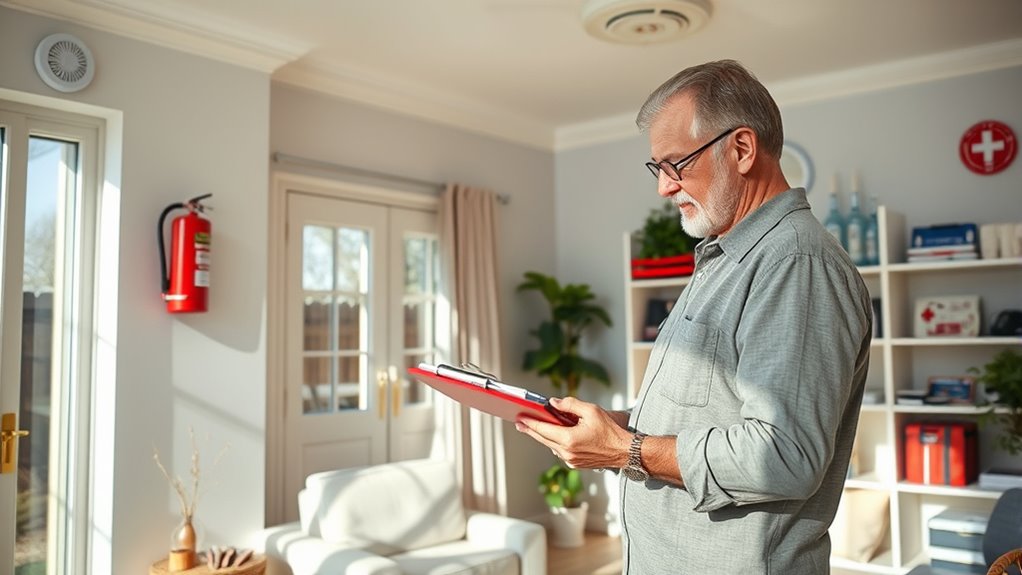
Creating and practicing emergency plans is essential to guarantee everyone in your household knows how to respond quickly and safely during unexpected situations. Regular emergency drills help reinforce procedures, making responses instinctive. Clear family communication is crucial; everyone should understand each other’s roles and safe meeting points. To strengthen your plan, consider:
- Establishing specific escape routes from each room
- Assigning roles for family members during emergencies
- Setting up a communication plan with emergency contacts
- Conducting regular family drills to test readiness
- Monitoring for safety hazards like potential fire risks or structural issues can help prevent emergencies before they occur
Frequently Asked Questions
How Often Should I Update My Home Safety Checklist?
You should update your home safety checklist at least every six months or whenever you experience major changes, like new fire hazards or renovations. Regular updates guarantee your emergency preparedness stays current, helping you identify potential fire hazards early. By staying proactive, you can minimize risks and keep your home safe. Remember, consistent reviews are key to maintaining a secure environment for you and your loved ones.
What Safety Measures Are Necessary for Pet-Friendly Homes?
In a pet-friendly home, you need to focus on pet proofing essentials like securing electrical cords, removing toxic plants, and storing harmful substances out of reach. Implement hazard prevention strategies such as using baby gates, covering outlets, and keeping small objects off the floor. Regularly check for new dangers, and always supervise your pets. These steps help keep your home safe, preventing accidents and ensuring your pets stay healthy.
How Can I Make My Home More Accessible for Elderly Residents?
Imagine stepping into a home where every surface feels tailored for comfort and safety. To make your home more accessible for elderly residents, install assistive technology like grab bars and motion-activated lighting. Use mobility aids such as walkers or stairlifts to navigate easily. Clear pathways free of clutter, and verify countertops are at comfortable heights. These simple changes create a warm, safe space where your loved ones can move confidently and independently.
What Are the Signs of Hidden Mold or Indoor Air Hazards?
You should look for signs of hidden mold or indoor air hazards by noticing musty odors, visible discoloration, or water stains on walls and ceilings. Mold detection involves inspecting damp areas like bathrooms, basements, and around windows. Poor air quality may cause allergy symptoms or respiratory issues. Regularly check ventilation systems, use air purifiers, and guarantee proper humidity levels to maintain healthy indoor air and prevent unseen mold growth.
How Do I Evaluate Safety in Multi-Story or Split-Level Homes?
Did you know that falls are the leading cause of injury in multi-story homes? To evaluate safety, check that fire escape routes are clear and accessible on every level. Inspect stair safety by ensuring handrails are sturdy and treads aren’t loose or slippery. Test lighting to prevent trips, and verify that all stairways meet safety codes. Regularly review these elements to keep your multi-story or split-level home secure for everyone.
Conclusion
By thoroughly checking your home’s safety measures, you create a secure environment. Yet, despite all the alarms and locks, it’s your awareness and preparedness that truly protect you. Safety isn’t just about devices; it’s about knowing your escape routes and staying vigilant. When you balance proper safety checks with ongoing awareness, you transform your house from a mere structure into a safe haven—where peace of mind outweighs any hazard lurking inside.

